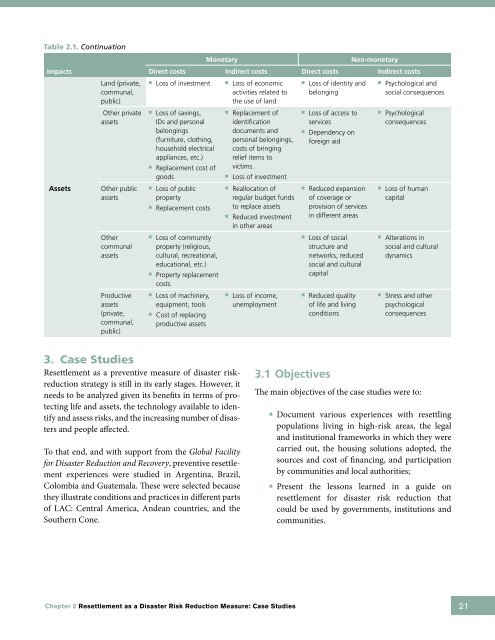Preventive Resettlement of Populations at Risk of Disaster - GFDRR
Preventive Resettlement of Populations at Risk of Disaster - GFDRR
Preventive Resettlement of Populations at Risk of Disaster - GFDRR
Create successful ePaper yourself
Turn your PDF publications into a flip-book with our unique Google optimized e-Paper software.
Table 2.1. Continu<strong>at</strong>ion<br />
Impacts<br />
Assets<br />
Land (priv<strong>at</strong>e,<br />
communal,<br />
public)<br />
Other priv<strong>at</strong>e<br />
assets<br />
Other public<br />
assets<br />
Other<br />
communal<br />
assets<br />
Productive<br />
assets<br />
(priv<strong>at</strong>e,<br />
communal,<br />
public)<br />
Monetary<br />
Non-monetary<br />
Direct costs Indirect costs Direct costs Indirect costs<br />
■■<br />
Loss <strong>of</strong> investment ■■<br />
Loss <strong>of</strong> economic<br />
activities rel<strong>at</strong>ed to<br />
the use <strong>of</strong> land<br />
■■<br />
■■<br />
■■<br />
■■<br />
■■<br />
■■<br />
■■<br />
■■<br />
Loss <strong>of</strong> savings,<br />
IDs and personal<br />
belongings<br />
(furniture, clothing,<br />
household electrical<br />
appliances, etc.)<br />
Replacement cost <strong>of</strong><br />
goods<br />
Loss <strong>of</strong> public<br />
property<br />
Replacement costs<br />
Loss <strong>of</strong> community<br />
property (religious,<br />
cultural, recre<strong>at</strong>ional,<br />
educ<strong>at</strong>ional, etc.)<br />
Property replacement<br />
costs<br />
Loss <strong>of</strong> machinery,<br />
equipment, tools<br />
Cost <strong>of</strong> replacing<br />
productive assets<br />
■■<br />
■■<br />
■■<br />
■■<br />
■■<br />
Replacement <strong>of</strong><br />
identific<strong>at</strong>ion<br />
documents and<br />
personal belongings,<br />
costs <strong>of</strong> bringing<br />
relief items to<br />
victims.<br />
Loss <strong>of</strong> investment<br />
Realloc<strong>at</strong>ion <strong>of</strong><br />
regular budget funds<br />
to replace assets<br />
Reduced investment<br />
in other areas<br />
Loss <strong>of</strong> income,<br />
unemployment<br />
■■<br />
■■<br />
■■<br />
■■<br />
■■<br />
■■<br />
Loss <strong>of</strong> identity and<br />
belonging<br />
Loss <strong>of</strong> access to<br />
services<br />
Dependency on<br />
foreign aid<br />
Reduced expansion<br />
<strong>of</strong> coverage or<br />
provision <strong>of</strong> services<br />
in different areas<br />
Loss <strong>of</strong> social<br />
structure and<br />
networks, reduced<br />
social and cultural<br />
capital<br />
Reduced quality<br />
<strong>of</strong> life and living<br />
conditions<br />
■■<br />
■■<br />
■■<br />
■■<br />
■■<br />
Psychological and<br />
social consequences<br />
Psychological<br />
consequences<br />
Loss <strong>of</strong> human<br />
capital<br />
Alter<strong>at</strong>ions in<br />
social and cultural<br />
dynamics<br />
Stress and other<br />
psychological<br />
consequences<br />
3. Case Studies<br />
<strong>Resettlement</strong> as a preventive measure <strong>of</strong> disaster riskreduction<br />
str<strong>at</strong>egy is still in its early stages. However, it<br />
needs to be analyzed given its benefits in terms <strong>of</strong> protecting<br />
life and assets, the technology available to identify<br />
and assess risks, and the increasing number <strong>of</strong> disasters<br />
and people affected.<br />
To th<strong>at</strong> end, and with support from the Global Facility<br />
for <strong>Disaster</strong> Reduction and Recovery, preventive resettlement<br />
experiences were studied in Argentina, Brazil,<br />
Colombia and Gu<strong>at</strong>emala. These were selected because<br />
they illustr<strong>at</strong>e conditions and practices in different parts<br />
<strong>of</strong> LAC: Central America, Andean countries, and the<br />
Southern Cone.<br />
3.1 Objectives<br />
The main objectives <strong>of</strong> the case studies were to:<br />
■■<br />
■■<br />
Document various experiences with resettling<br />
popul<strong>at</strong>ions living in high-risk areas, the legal<br />
and institutional frameworks in which they were<br />
carried out, the housing solutions adopted, the<br />
sources and cost <strong>of</strong> financing, and particip<strong>at</strong>ion<br />
by communities and local authorities;<br />
Present the lessons learned in a guide on<br />
resettlement for disaster risk reduction th<strong>at</strong><br />
could be used by governments, institutions and<br />
communities.<br />
Chapter 2 <strong>Resettlement</strong> as a <strong>Disaster</strong> <strong>Risk</strong> Reduction Measure: Case Studies<br />
21
















